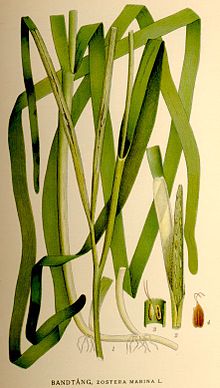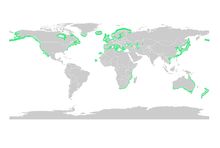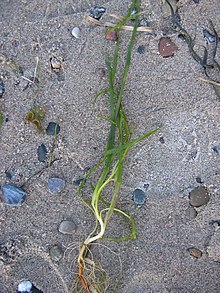Sea grasses
| Sea grasses | ||||||||||||
|---|---|---|---|---|---|---|---|---|---|---|---|---|

Seagrass ( Zostera spec.) |
||||||||||||
| Systematics | ||||||||||||
|
||||||||||||
| Scientific name | ||||||||||||
| Zostera | ||||||||||||
| L. |
The sea grasses ( Zostera ) are a genus of plants in the family of the sea grass plants (Zosteraceae). The approximately 16 species are some of the few species of flowering plants that live submerged in the oceans . They can grow submerged to a depth of 15 meters. Similar looking plant species from other genera and families are also called "sea grasses".
Description and ecology


Vegetative characteristics
Zostera species grow as perennial herbaceous plants . They appear grass-like and are submerged (submerged) aquatic plants . They are anchored in the sea floor with adventitious roots on a monopodial rhizome . The alternate and two lines arranged leaves have linealische leaf blades.
Generative characteristics
Zostera species are single sexed ( monoecious ). The functionally unisexual flowers do not have an inflorescence or bracts and are arranged in two rows on each side of a flattened spike axis (the spadix ) and are enclosed in a single bract (the spathe ) at flowering time . The male flower contains a stamen. The flower contains only one upper ovary which consists of two, but apparently only one carpel. The pollination takes place via the water with thread pollen.
Seagrasses form small nut fruits that are cylindrical in shape and have a two-column style at the tip.
Where seawater burns on shallow beaches, spherical balls of seaweed form under the effect of cylindrical water eddies and gravity.

Systematic distribution
The genus Zostera was established in 1753 by Carl von Linné in Species Plantarum with the type species Zostera marina . The generic name Zostera is based on the Greek word "zoster", which means something like "belt" and refers to the flat, ribbon-shaped leaves.
The 16 or so Zostera species thrive in cold, cool and warm, but not tropically warm, coastal waters almost worldwide. They are most common on the coasts of temperate areas of the northern hemisphere. Six species are known from Australian, five species from Chinese and two species from North American coastlines. They only occur in seas and mostly grow in seagrass meadows .

The genus Zostera contains about 16 species:
- Zostera angustifolia (Hornem.) Rchb. : It occurs from Northern Europe to Asiatic Russia.
- Zostera asiatica Miki : It occurs from Asiatic Russia to Korea and from Sakhalin to northern Japan.
- Zostera caespitosa Miki : It occurs from the Kuril Islands to northeastern China.
- Zostera capensis Setch. : It occurs from Kenya to South Africa and Madagascar
- Zostera capricorni Ash. ; Home: New Guinea to New Zealand
- Zostera caulescens Miki : It occurs from northeastern China to Korea and Kuriles to western Japan.
- Zostera chilensis (J.Kuo) SWLJacobs & Les : This endemic occurs only in Coquimbo, Chile.
- Zostera japonica Ash. & Graebn. : It occurs from Russia's Far East to Vietnam.
- Common seaweed ( Zostera marina L. ): It is widespread in the northern hemisphere.
- Zostera mucronata Hartog : It occurs only from southwest to southern Australia.
- Zostera muelleri Irmisch ex Asch. : It occurs only from southern Australia to Tasmania .
- Zostera nigricaulis (J.Kuo) SWLJacobs & Les : It occurs only in southern Australia.
- Dwarf seaweed ( Zostera noltii Hornem. ): It occurs on the coasts from Europe to Mauritania and the Mediterranean to Central Asia .
- Zostera novazelandica Setch. : It only occurs in New Zealand.
- Zostera polychlamys (J.Kuo) SWLJacobs & Les : It only occurs in southern Australia.
- Zostera tasmanica M. Martens ex Asch. : It occurs only from southwest to southern Australia.
use
Since seaweed - together with algae and other plant residues - represents a large amount of biomass on the beaches of the North Sea and Baltic Sea , there are different usage concepts. So far, seaweed landed on European tourist beaches has been collected and either disposed of in landfills or occasionally plowed under in fields as fertilizer. In Denmark it is also used as insulation and for the renovation of the famous seagrass roofs on Læsø .
Material use

Dried seaweed was previously used as upholstery material for sofas and the like, mattresses and as packaging material (although the similarly used quaking grass sedge was also known as "seaweed"). In today's "classic upholstery", palm fiber (Afrique) has replaced seaweed. Seaweed served as an insulating layer in the first refrigerator. South Pole researcher Robert Falcon Scott has insulated his research station with seaweed. In New York, the Radio City Music Hall and the Rockefeller Center are insulated with seagrass insulation mats from Cabot's Quilt (seagrass).
In addition to products such as cat litter and erosion protection mats, seaweed has proven to be an efficient ecological insulation material that can be processed both as a mat and as a fill. In the meantime, seaweed has been recognized as an insulating material by the German Institute for Structural Engineering . As a bed, seagrass insulation has a WLG value of 045, stores heat very well ( heat capacity 2.0 kJ / (kg × K)), has relatively good dehumidifying properties and is inherently flame retardant. In addition, seaweed is also resistant to vermin (mites, insects, mice, etc.) and is therefore particularly suitable as a cushioning material for those allergic to house dust. It offers good sound insulation. In 1997, the Klützer Winkel office founded the "Disposal through recycling" project, which was intended to open up possible uses for the overburden. In Germany, seaweed insulation mats were produced on this basis until 2006/2007, but production has since been discontinued.
Seagrass pressed into round bales has been on the market again as an insulation material since 2012.
Studies deal with the possible use of seaweed as additives for cosmetics, wellness applications, products for the food industry and pharmaceuticals.
Seagrass can also be used to weave baskets.
Energetic use
In principle, seaweed can also be used as a biogas substrate together with algae. The problem here, however, is the low biogas yield of 8 to 20 m 3 from a ton of algae-seaweed mixture and the very high proportion of sand in the collections with up to 50 percent. In a long-term trial by Hanseatische Umwelt GmbH, the fermentation properties of the algae-seagrass mixture and other landscape conservation biomass of the coastal region were investigated; a pilot plant was implemented in 2015 with the realization that it could be cost-neutral.
swell
- Robert R. Haynes: Zosteraceae. In: Flora of North America Editorial Committee (Ed.): Flora of North America North of Mexico . Volume 22: Magnoliophyta: Alismatidae, Arecidae, Commelinidae (in part), and Zingiberidae . Oxford University Press, New York / Oxford a. a. 2000, ISBN 0-19-513729-9 , pp. 90–94 (English, limited preview in Google Book Search). , same text online as the printed work. (Section description)
- Youhao Guo, Robert R. Haynes, C. Barre Hellquist: Zosteraceae. In: Wu Zheng-yi, Peter H. Raven, Deyuan Hong (Eds.): Flora of China . Volume 23: Acoraceae through Cyperaceae . Science Press / Missouri Botanical Garden Press, Beijing / St. Louis 2010, ISBN 978-1-930723-99-3 , pp. 106 (English). , online , PDF file (sections description, classification and distribution).
- Leslie Watson: Zosteraceae. In: Western Australian Herbarium (Ed.): FloraBase. The Western Australian Flora. Department of Environment and Conservation 2008, online (section description)
- SWL Jacobs, DH Les: New combinations in Zostera (Zosteraceae). In: Telopea. Volume 12, No. 3, 2009, pp. 419-423. ISSN 0312-9764 PDF file.
Individual evidence
- ↑ Carl von Linné: Species Plantarum. Volume 2, Impensis Laurentii Salvii, Holmiae 1753, p. 968 digitized .
- ^ Zostera at Tropicos.org. Missouri Botanical Garden, St. Louis
- ↑ Vernon Hilton Heywood (ed.): Flowering plants of the world . Birkhäuser, Basel / Bonn / Stuttgart 1982, ISBN 3-7643-1305-6 (English: Flowering Plants of the World .).
- ↑ a b c d e f g h i j k l m n o Rafaël Govaerts (Ed.): Zostera. In: World Checklist of Selected Plant Families (WCSP) - The Board of Trustees of the Royal Botanic Gardens, Kew . Retrieved June 7, 2020.
- ^ A b Walter Erhardt , Erich Götz, Nils Bödeker, Siegmund Seybold: The great pikeperch. Encyclopedia of Plant Names. Volume 2. Types and varieties. Eugen Ulmer, Stuttgart 2008, ISBN 978-3-8001-5406-7 .
- ↑ Læsø Seaweed Houses .
- ↑ Eelgrass in History. Seagrass.LI, accessed September 6, 2018 .
- ↑ Georg Conradi: seaweed insulation: An alternative to alternative insulation materials. In: Building topic natural insulation materials. 2006, ISBN 3-8167-6916-0 , pp. 73-76.
- ↑ a b How algae are converted into electricity ( Memento from February 1, 2012 in the Internet Archive ) (PDF; 72 kB). Financial Times Deutschland, October 19, 2009.
- ↑ Project description Energetic utilization of landscape maintenance material - thatch, reeds, etc. - Origin Elbe - Weser bank and North Sea ( page no longer available , search in web archives ) Info: The link was automatically marked as defective. Please check the link according to the instructions and then remove this notice. , As of October 10, 2009.
- ↑ Lecture Martin Staemmler: Utilization possibilities of Treibsel against the background of industrial use (PDF). Hanseatische Umwelt CAM GmbH, as of October 5, 2017.
